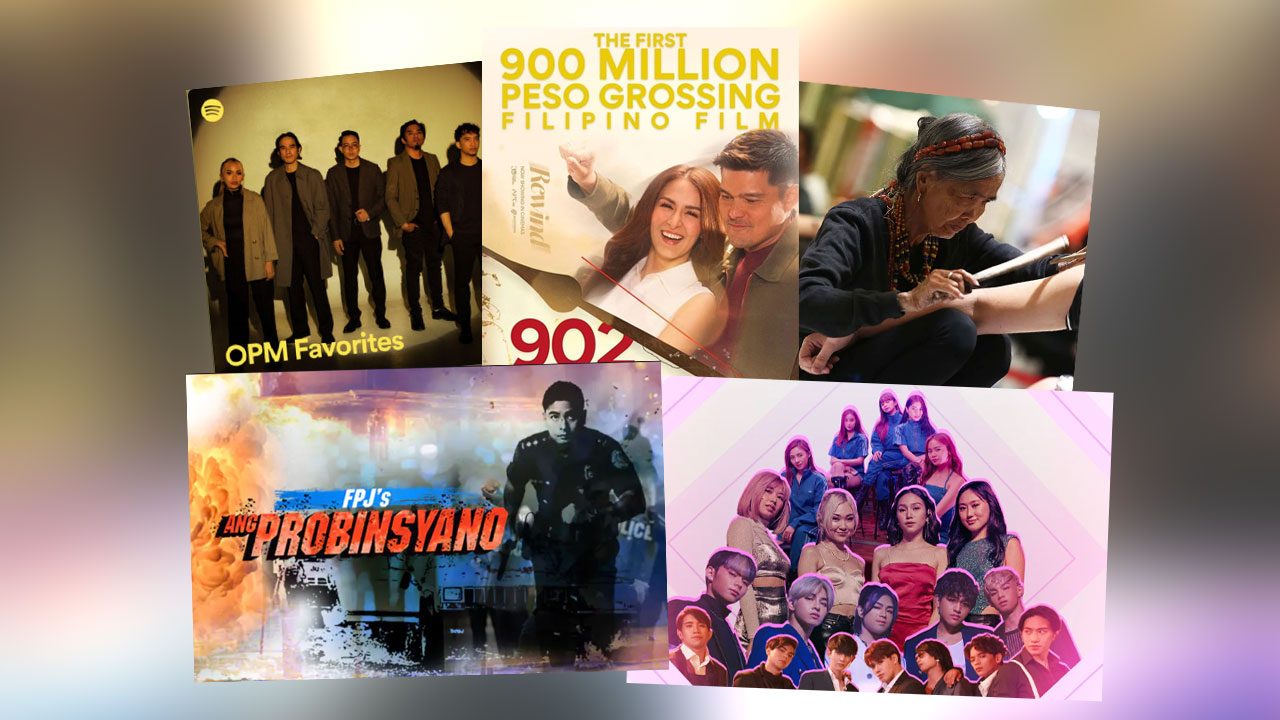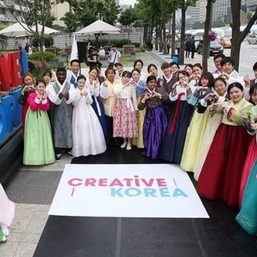SUMMARY
This is AI generated summarization, which may have errors. For context, always refer to the full article.

MANILA, Philippines – As millions of Filipinos binge on South Korea’s K-dramas, marvel over Oscar-winning movies like Parasite, follow K-pop stars and other aspects of their Asian neighbor’s creative economy, there is now an official assessment of the Philippines’ own creative industries.
In the Philippine Statistics Authority’s (PSA) first compilation of Philippine Creative Economy Satellite Accounts (PCESA) released on Thursday, March 21, the central statistics authority said the Philippines’ creative economy amounted to P1.72 trillion in 2023, contributing 7.1% to the gross domestic product (GDP).
“Creativity plays an important role in improving the economic performance of a country as it can attract potential investments and promote competitive advantage,” the PSA said.
The Philippines’ creative economy was valued at P1.3 trillion in 2018, which went up to P1.47 trillion in 2019. Due to the pandemic, it declined to P1.34 trillion in 2019, but recovered from 2021 to 2023.

From a value of P1.34 trillion in 2020 and negative 9% growth, the Philippines’ creative economy grew 7.1% in 2021, 12.2% in 2022, and 6.9% in 2023.
In terms of employment, there were 6.9 million people in creative industries in 2018, which fell to 5.5 million in 2020. However, employment recovered in 2021 to 6.3 million in 2021, 6.9 million in 2022, and 7.2 million in 2023.

Human creativity
But who exactly are part of the Philippines’ creative industries?
The PSA developed its creative economy accounts by taking off from Republic Act 11904 or the Philippine Creative Industries Development Act, which lapsed into law on July 2022.
This law mandates the State to “promote and support the development of Philippine creative industries by protecting and strengthening the rights and capacities of creative firms, artists, artisans, creators, workers, indigenous cultural communities, content providers, and stakeholders in the creative industries….”
It defines creative industries as “trades involving persons, whether natural or juridical, that produce cultural, artistic, and innovative goods and services originating in human creativity, skill, and talent and having a potential to create wealth and livelihood through the generation and utilization of intellectual property.”
From this, the PSA developed an “operational definition” of creative economy, which is: “economic activities primarily responsible for the creation, production, commercialization, distribution, and consumption of goods and services that use creativity and intellectual capital as primary inputs.”
The PSA says creative goods and services should meet the following criteria:
- Its production requires some input of human creativity
- It contains symbolic messages
- It has an intellectual property factor
- It is a novel or a new product
You are part of the Philippines’ creative industries if you are engaged in the following:
- Audio and audiovisual media activities comprising of manufacturing, renting, trading of live and recorded audio and audiovisual media
- Digital interactive goods and service activities including manufacturing, renting, trading of computers, software, programs, mobile applications, and electronic games
- Advertising, research and development, and other artistic service activities referring to advertising, research and development, recreational services, translation and interpretation including construction of other civil engineering projects
- Symbols and images and other related activities including manufacturing, renting, trading of symbols and images in textiles, garments, footwear, furniture, jewelry, fashion and accessory, toys, etc.
- Media publishing and printing activities comprising of publishing and printing, renting, trading of books, magazines, newspapers, journals including manufacturing of ink, hand-made paper, etc.
- Music, arts, and entertainment activities referring to manufacturing and trading of musical instruments, publishing of music; casting, booking; operations of concerts and theaters including activities in creative arts and entertainment
- Visual arts activities including manufacturing, trading, distribution, and preservation of works which are visual in nature including paintings, drawings, photographs, antiques, and other visual arts
- Traditional cultural expression activities which are related to customs, practices, traditions, culture, heritage including arts and crafts, gastronomy, culinary practices, cultural festivals, and celebrations
- Art galleries, museums, ballrooms, conventions and trade shows and related activities including operation of art galleries, ballrooms, discotheques, conventions and trade shows, libraries and archives, botanical and zoological gardens, museums and preservation of historical sites and buildings
From this definition, the PSA said the biggest contributors to employment are those engaged in “traditional cultural expression activities” with the highest share of 35.5% in 2023.
“This was followed by symbols and images and other related activities and advertising, research and development, and other artistic service activities with 30.3 percent and 17.8 percent, respectively,” it said.
Among the biggest companies involved in this broad definition would be GMA Network, ABS-CBN Corporation, and Manny Pangilinan's MediaQuest Holdings; celebrities such as Coco Martin, Vice Ganda, Anne Curtis, and Sarah Geronimo; digital content creators and influencers on YouTube, Facebook/Instagram, and TikTok; indigenous artists such as Whang-Od; advertising companies engaged in promoting Philippine food and beverage companies such as Jollibee and San Miguel Beer, among others.
Among the world-renowned Filipino designers are Kenneth Cobonpue, Budji Layug in furniture; Michael Cinco, Monique Lhuillier, Rajo Laurel, Francis Libiran in fashion.
Famous Filipinos in arts include BenCab, Ronald Ventura, Ramon Orlina, Michael Cacnio, Julie Lluch, Toym Imao.
Other Filipino entertainment icons are Lea Salonga, Arnel Pineda, and Gary V.
The PSA said it started this “pilot initiative” to assess the scope and coverage of the Philippines’ creative economy in 2022.
It then drafted an interim methodology for the compilation of the Philippine Creative Economy Satellite Accounts.
“With the growing supply and demand for innovative and creative goods and services, it is important to capture the economic contribution of the creative sector in the country,” the PSA said.
The PSA said its methodology is still “preliminary” and is “currently being refined.”
South Korea's creative economy
According to the United Nations Conference on Trade and Development (UNCTAD), South Korea’s creative sectors employed over 600,000 people in 2021. Its creative economy generated $12.4 billion in export revenues the same year, growing at 4% to 5% annually. Revenues from South Korea’s creative sectors were more than twice its consumer electronics exports (e.g. mobile phones, smart TVs) of $4.7 billion.
Former economic planning secretary Cielito Habito, in a 2023 column, said it was time the Philippines makes a big push for its “creative economy.”
“Think of how much more prosperous our economy could be if we could do what the Koreans did to create so much wealth (and jobs) from their ‘cultural economy.’ Given the Filipinos’ widely acknowledged artistic and creative talent, often described to be the richest and most versatile in Asia, this need not be a pipe dream beyond our reach. Now is the time for us to deliberately plan and work on ‘doing a Korea,’ and cash in much more than we have so far been able to, on our creative economy,” he said. – Rappler.com
ALSO ON RAPPLER
- South Korea’s Creative Economy Agenda
- The K-pop model and why it’s important to build a creative economy
- South Korea to launch Hallyu visa for K-pop and K-drama fans
- BTS hit ‘Dynamite’ worth $1.4 billion to South Korea – government
- 'It's Showtime' to air on GMA Channel 7
- Why haven’t we won an Oscar? House probe puts spotlight on Philippine cinema
Add a comment
How does this make you feel?



![[OPINION] From ‘Puyat’ to ‘Tulog’: Clout-chasing street signs disrespected history](https://www.rappler.com/tachyon/2024/07/gil-puyat-july-26-2024.jpg?resize=257%2C257&crop=389px%2C0px%2C1080px%2C1080px)




















































![[Only IN Hollywood] ‘House of the Dragon’ Team Black reveal more dragons, intrigues in season 2](https://www.rappler.com/tachyon/2024/06/HouseoftheDragon2-Showrunner-Ryan-Condal-left-with-Team-Black-from-left-Emma-DArcy-Matt-Smith-Steve-Toussaint-Bethany-Antonia-Harry-Collett-and-Eve-Best-Photo-by-Ruben-V.-Nepales-Rappler1-scaled.jpg?resize=257%2C257&crop=451px%2C0px%2C1726px%2C1726px)
There are no comments yet. Add your comment to start the conversation.